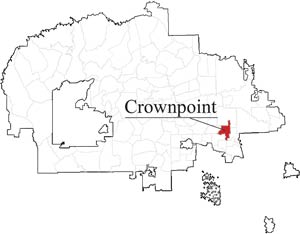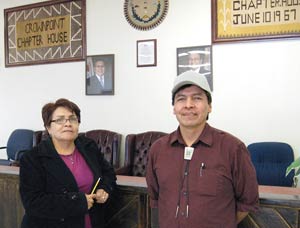Split down the middle
The progressive chapter of Crownpoint is half ghost town
By CIndy Yurth
Tséyi' Bureau
CROWNPOINT, N.M., February 21, 2013
(Editor's note: In an effort to chronicle the beauty and diversity of the Navajo Nation, as well as its issues, the Navajo Times has committed to visiting all 110 chapters in alphabetical order. This is the 23rd in the series.)



(Times photo — Cindy Yurth)
TOP: A largely abandoned BIA compound detracts from Crownpoint's progressive character. The BIA lacks the funds to tear all the buildings down. The chapter is working to get some of executive order BIA land into trust so it can reclaim or demolish the buildings, but it's a drawn-out process.
SECOND FROM TOP: Crownpoint Chapter President Rita Capitan and legislative aide Leonard Perry pose in Crownpoint's chapter house, decorated with some of the region's famous weavings.
Y ou might think being the headquarters of a Bureau of Indian Affairs agency would be an advantage for a chapter.
All the expertise and services of the federal government would be right at your disposal, and people coming in from the surrounding chapters to do business would spend their money on gas and a meal.
But, as Crownpoint — headquarters of the BIA Navajo Region's Eastern Agency — has discovered, it also means slamming up against the federal bureaucracy every time you try to get something done.
Even as construction is going on in every direction, this chapter, arguably one of the most progressive on the Navajo Nation, is stuck with a sprawling ghost town on some of its most desirable land.
"This is trust land," explained former chapter president Charles Long, standing on the chapter compound. "But across the street, that's all executive order land."
What that means, explained Jerry DeGroat, realty specialist for Crownpoint Agency, is that the federal government specifically set aside a big chunk of Crownpoint for the BIA's operations: a school, housing and government offices.
Over the years, most of the buildings — some of which date back almost to the Agency's founding in 1910 — have been abandoned and boarded up.
To raze the buildings is no simple matter. Many of them are full of asbestos and lead paint, and expensive specialists need to be hired to clean them up properly.
"It's frustrating," said Leonard Perry. "The BIA doesn't have money to tear them down, and for us to get a hold of them, it's really difficult."
It's easier to call Perry "Mr. Crownpoint" than to list his affiliations. He is the district assistant to Council Delegate Danny Simpson, president of the non-profit Crownpoint Cultural Preservation and Development Council, a member of the land-use planning committee and editor of the local newspaper, Crownpoint Baahane'.
Since he obviously doesn't have enough to do, he's also getting a Ph.D. from the University of New Mexico in Education Thought and Sociocultural Studies.
If you're going to ask Perry about Crownpoint, be prepared to sit down for a while. His hometown is his favorite subject.
Ask him about the history, for example, and he goes back a thousand years.
"We weren't the first ones here," stated Perry, motioning toward the Anasazi ruin known to the Diné as Kin Ya'aa, namesake of the Towering House Clan.
According to Perry, you can make out the outline of an ancient road running between Kin Ya'aa and the spectacular ruins of Chaco Canyon, and also between Kin Ya'aa and another local ruin, Muddy Water.
"If you ask the Pueblo, we had nothing to do with that civilization," said Perry. "But it's in our oral history."
So numerous are the Anasazi sites in Crownpoint that "it's an impediment to development," Perry said. "Every so often, we have to move some housing because somebody found a burial site under it."
Agency capital
But the modern history of Crownpoint starts 103 years ago, in 1910. That's when the BIA named the dusty outpost the capital of its new Eastern Agency.
A school and government offices sprang up, bringing jobs and commerce. Roads were built and paved.
By the 1950s and 60s, "It was beautiful here," reminisced Franklin Freeland, a Crownpoint native and one of the first locals to obtain a Ph.D. "There were students who would come out every summer — I don't know if they were something like the Peace Corps or what. They would chisel away on some of these big old stones. We'd make our own cement. They built our original chapter house."
Crownpoint may have been the only Navajo community to have its own teen canteen.
"It was every Wednesday night at the chapter house," said Freeland, 65. "They had a jukebox and everything. You could hang out and dance to the music of the day."
Crownpoint was also one of the few places on the Navajo Nation served by the Greyhound bus line. After they graduated from the BIA elementary, students were sent all over the country for junior high and high school, with parents assuming the education would be better the farther they got from the rez.
"Oklahoma, California, Nevada, Utah, even Oregon," Freeland said, ticking off the states whose Indian boarding schools took in Crownpoint students.
When it was time to send the kids back to school after summer vacation, "it was something to see," Freeland recalled. "They'd ride up in wagons or on horseback with their parents, waiting to load onto the bus. Some of them didn't even have suitcases, just cardboard boxes with their stuff."
In 1968, a local trader initiated the Crownpoint Rug Auction, a monthly tradition that survives to this day (though its future is a bit uncertain as the BIA is tearing down the old elementary school, whose gym hosts the auction).
But there were plenty of good weavers in Crownpoint before that, Freeland said.
"When I was a kid, we used to trade rugs with Jemez Pueblo," he said. "They would bring jewelry and bread, we'd trade them rugs and buckskin."
At that time, more Puebloans spoke Spanish than English, so the Navajo learned Spanish as a lingua franca, Freeland said.
"Some of the older people still speak Spanish," he said. "Sometimes we'll speak it when we get together, just to keep it up."
Moving forward
In spite of its venerable history, Crownpoint is far from being stuck in the past. You'll see both solar panels and a wind turbine on the chapter compound, as well as various communications towers.
A new elementary school is going up, and, across town, a new justice center to house police, courts and a jail. A wellness center is in the works by the high school.
Navajo Oil & Gas is waiting for the land clearance to start putting up a convenience store at the junction of State Highway 371 and Navajo Route 9.
Navajo Technical College, whose main campus is here, is expanding and aiming to offer graduate degrees before long.
"We really need to start utilizing the college more," opined Perry. "They could really be a resource for us as we develop our community."
Crownpoint has a Basha's with a deli and a flea market boasting, according to Chapter President Rita Capitan, "the best Navajo burgers and mutton sandwiches on the rez."
But "we really need a sit-down restaurant," Capitan sighed.
Also on the wish list: a motel, a visitors' center and museum, a feed store, a cultural amphitheater and an arts-and-crafts cooperative.
Once the old school is razed, the chapter would like to build a multi-story office building that could offer state, federal and chapter services in the same structure — "a one-stop shop for those who come to town to get services," Perry explained.
But though government has been Crownpoint's bread and butter, Perry firmly believes private enterprise is the marmalade.
"Just wait until we get certified," he said. "Then the entrepreneurship will come in."
Unlike nearby Church Rock Chapter, however, you won't see Crownpoint Chapter inviting uranium companies in — not if Capitan has anything to say about it.
"My gut feeling is, no matter how much they tell people it's going to be safe and things are different now, it's just too hard to believe," Capitan declared. "Crownpoint has always been known for its good water. We don't want any outside companies coming in and messing with it."
Crownpoint at a glance
Name — The old part of town is situated in a round depression surrounded by rocky crags like the points of a crown. But the Diné have long known this place as T'iis Tsooz nideeshghiizh (Skinny Tree Canyon) after a spring surrounded by tall, slender trees.
Population — 2,729
Land area — 7.1 square miles
Assets — Navajo Technical College main campus, Diné College satellite campus, IHS facility, shopping center, convenience store, thriving flea market, a local newsletter
Claim to fame — A nearby Anasazi ruin, Kin Ya'aa, is the namesake of the Kinya'aanii, or Towering House Clan. Crownpoint is the headquarters of the BIA's Eastern Navajo Agency. It's also, according to some, the home of "The Howler," a creature who sometimes wakes up residents with its unearthly scream. (Chapter officials say The Howler hasn't been heard from all winter, however.)
Problems — feral animals, drug and gang activity, lots of abandoned buildings

